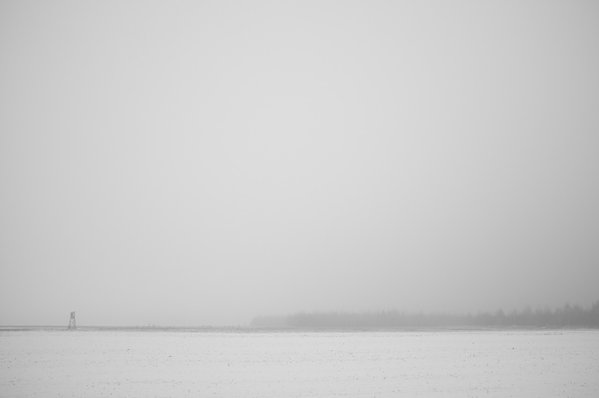Ambients: Ramūnas Motiekaitis’ Digital Release
- Sept. 19, 2017
Attention to Surrounding Experience
Povilas Vaitkevičius
As economical as it is in grammatical sense, the title of the composer’s new digital release is directly linked to the character of music in this set. Here, the term ambient seems to indicate the relationship between the surrounding environment and the scope of sounds the composer employs rather than the genre of music. Clearly, the term as such points to the attentiveness to everything arround you, or the ambience, but the tracks on this release often maintain this type of “moral position” even when their structures drift away from the programmatic features attributable to ambient music. Describing the latter, I would cautiously speak of long and sustained tones suggesting the mood of lingering. It is the first and the last composition that correspond this description at the greatest extent. By opening and closing the content-space of this set, they (sur)round it, which brings our minds back to the semantic meaning of the word ambient. Moreover, the interplay between the two digits, 6 and 9, does not seem to be accidental either.Mobile 6 prefers to stay clear from disturbing the space within which it manifests itself; it tries to approach the existence of that space but does not influence it by its own existence. This latter assumption is supported by the low level of recording. Occasional harsher and dissonant patterns of sound fail to unsettle the mood; they resemble a fleeting reflection of sun inside a room from a window pane. I am intentionally using the concept of a room here because I tend to describe the electronic compositions by Motiekaitis as chamber music too. The imagined space within which the soundscapes of this release manifest themselves seems to be a rather intimate and a neatly simple one. A person approaches it as a mute and somewhat ontological experience. Piccolo-like sets of sound also hint to certain associations with liturgical music, although they occur mainly because of the form itself. Clearly, it is the sheer contemplativity of this music that links it to liturgy, but the above-mentioned minimalistic bonds with space is nevertheless its main feature. Even for those unaware of the composer’s studies in Japan and his ongoing practice in teaching Japanese culture in Lithuania, his aesthetic stance might seem very much reminiscent of the philosophical ideas originating in Eastern Asia. It manifests itself even more fully in White Flutes, a piece composed using the sounds of a Japanese flute. Without additional information, the task of recognizing the origins of the sound would probably prove almost impossible, but still this is not vital in shaping the relationship between the piece and a listener. The audible cartography of the latter is much alike that employed in Mobile but here it offers somewhat smoother landscapes. I’m tempted to call the composition “more plant-like” as it transports listeners from the aforementioned room to spaces outside it. This does not mean, though, that it loses its chamber qualities, because the outside space remains intimate enough, the space of close ranges where surrounding objects should be observed without qualifying them. It’s much like sitting by a pond in a Japanese garden.
The image of a pond takes us to the next piece, Woods-Winds--Waters-Winters----Windows. Yes, the title features the word “water”, but there is much more of it in the music which ripples like the aforementioned pond and its soundscape offers associations with the sounds produced by living creatures inside it. Again, the sequence of the five Ws creates a pictogram reminiscent of rippling water. Obviously, it is a subjective sequence of the imagery but the alternation of the organic matter and the elements in the title corresponds to that sequence. One might say I am too focussed at the verbal level, but that’s because I see it as a set of conditions suitable for the birth of respective impressions rather than an imperative description; it is useful in the search for inner links and helps us experience the “woody” substance of sounds, the windy emptiness of a window, or the white winter field.The theme of connectivity is, in turn, noticeable in the texture of I Can’t Get Through to You. While the surface here may only be determined in a stochastic manner, it serves as a ground for the search for points of contact capable of producing short-lived episodes of cosiness. The feeling of intimacy lingers not solely because of the title of the piece but rather due to the nearness of sounds and scrupulous attention to pauses between them. Due to the aforementioned reasons, the sounds hint to their earthly origins. This, again, marks something very personal, something that I would call “moral chamberness”. The second part of the title also indicates a certain internal, or chamber, space. In the horizon of my thoughts, I feel an urge to recall the concept of Lithuanian post-minimalism and, by trying to fit it in here, I tend to reduce it to the minimalism of meditative muteness; this is the kind of minimalism without repetitivity, the one that timidly invites to listen to inner conditions rather than to structures. The term “superminimalism” also emerges, but semantic values of its prefix “super-” appear to be too harsh among these soundscapes. I believe, “intimate minimalism” fits better.
In Mobile 9, the nine is the overturned six from the title of the first track in this collection. In graphic sense, this may even suggest the symbol of Yin and Yang and a symbolic connection between the beginning and the end of the release. Allowing a total freedom of imagination, one might see this mark on the surface of the CD (if this set would be released on CD) and turning together with it. The piece, as it was mentioned in the beginning, smoothly returns to the ambient flow of modes as tonal quietness calls for a naked eye that feels rather than labels. Compared to Mobile 6, the soundscape is more fluent and perhaps somewhat crystalic. It is rather fragile, and once again asks for careful observation – no disturbance, please.
This album offers the compositions based on the musical material that flows smoothly from one soundscape to the other. Obviously, subjective poetisation supports such conclusion. I am doing this for the sake of experience of quiet strata, the experience that may only be gained through careful listening.
The digital release can be ordered here.


